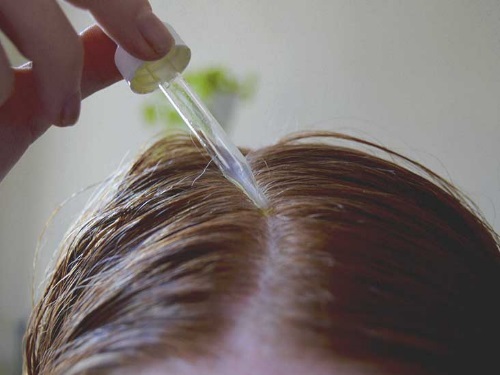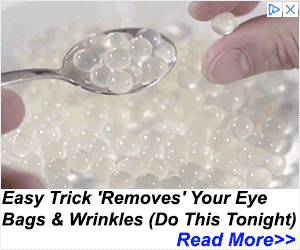Has your hair seen better days? Is it lackluster or does it just lack volume? Do you have split or dry ends? Is it thinning or getting patchy? You may think that it’s just genetics or that time takes its toll on your hair just as it does on the skin and the rest of the body; that’s just the way it goes. Or, you may think it’s about finding a miracle product to give you locks you love, and it’s time to shell out some cash. Before you pull out your wallet, you may want to look at your diet first. Quality nutrition can play an even bigger role in your hair thickness and volume than your haircare products. It can even help prevent or reduce patchiness. In fact, there are several foods for hair growth you’ll want to include in your diet.
BREAKING: 72-Year Old Grandma's Anti-Aging Discovery Sweeps The Nation
What Does Normal Hair Growth Look Like?
Hair is made up primarily of a protein called keratin, which also makes nails and is needed to form the outer layer of our skin. There are three layers on each hair:
- The outer layer is called the cuticle, which is thick, colorless, and acts as a protective layer.
- The cortex, which provides hair color depending on the level of melanin. This layer also determines if hair is curly or straight, depending on how it’s shaped.
- And the medulla, the innermost layer, which reflects light to help hair look shiny and healthy.
For most people, hair grows at about a half-inch a month, or around six inches per year, but many other factors can affect your natural hair growth, including genetics, sex, age, and nutrition, as well as whether you’ve experienced a recent illness. And get this: every one of the 100,000 to 350,000 hair follicles peppering the top of your head has its own blood supply. Thus, stimulating circulation on the head can help hair grow faster and stronger.
Hair follicles have a growth stage that lasts around 1,000 days (almost 3 years), and then they rest for just over 3 months (100 days). They then shed, and a new hair begins to grow in that follicle. However, this rate can vary from person to person, sometimes significantly. It can also be affected by your age, state of health, exposure to chemicals or toxins (including nicotine), hormone levels, stress, weight gain and loss (especially repeatedly or drastic), and what you eat.
We all shed hair daily. It’s a natural process. However, there may not be a lot you can do to prevent or reverse hair loss, for example, if you’ve been ill or just due to genetics. That said, if you have just recently noticed more significant hair loss, it’s time to make an appointment with your doctor, as hair loss can be a symptom of many medical conditions.
On the other hand, if you just want to grow longer, fuller, more beautiful shiny locks, then the most easily controlled aspect of hair growth is nutrition. For example, certain nutrient deficiencies can weaken hair follicles, which can slow re-growth and cause hair to break. Dozens of different foods can provide the nutrition you need to prevent deficiencies, and thus, keep your hair looking thicker, healthier, and more gorgeous.
Let’s dive into the best foods for hair growth.
The Best Foods For Hair Growth
If you have nutrient deficiencies in protein, biotin, iron, and vitamin D, one of the first places you’ll notice is in your hair. Keeping an eye on your hair health can help you better address any issues before they start to get out of hand. Here are some foods for hair growth to keep in your dietary rotation:
1. Eggs are high in biotin, vitamins A and D, B12, and protein. Protein is vital for a healthy scalp and hair, which is made up of mostly protein. And biotin is a B vitamin that has been shown to encourage hair growth and support a healthy scalp. A deficiency in biotin can lead to dry, brittle hair and nails. Eggs also provide two carotenoids—lutein and zeaxanthin—which are vital for the health of the eyes, skin, and of course, hair.
2. Fatty fish, like salmon, sardines, and mackerel, provide omega-3 fatty acids along with vitamin D and biotin, which also help the hair hold in moisture to become softer, more supple, stronger, and shinier. Seafood is also a good source of zinc, a mineral needed for cell reproduction, tissue growth, and repair. A zinc deficiency can lead to both hair loss and dandruff.
3. Red meat provides protein and iron, which are needed for thick, healthy, lustrous hair. Other quality sources of protein include chicken and turkey. However, you may want to reach for leaner cuts of meats, as higher-fat diets can increase testosterone levels, and high testosterone has been linked to hair loss.
4. Greek yogurt is another rich source of protein, which provides the building blocks of long, glowing locks. Just remember to reach for plain, unsweetened yogurt that provides live probiotics. (You can also use yogurt for a DIY hair treatment for greater shine.)
5. Chia seeds are another quality source of omega-3s, along with fiber and loads of antioxidants, which are also needed for hair thickness and growth. Chia seeds are also a good plant-based protein source, with 20% more protein than soybeans. And as we’ve already discussed, protein is a key nutrient for hair health.
6. Flaxseeds are rich in polyunsaturated fats, which help nourish the scalp, preventing dryness, and lead to smoother, softer locks.
7. Sunflower seeds are rich in zinc. Zinc is known to help stimulate follicle health, and it also is needed for protein synthesis and nutrient absorption. Zinc can also be found in meats and fish, but if you’re looking for a plant-based source, sunflower seeds top the list.
8. Walnuts provide healthy omega-3 fats to keep hair hydrated, and they also supply copper, which may help hold in color and slow premature greying. Nutrients in walnuts may also help shield hair against the harsh rays of the sun and thus protect your natural hair color.
9. Almonds, in a single serving, provide a day’s worth of your requirement for biotin, which helps thicken hair and potentially causes new growth for longer, silkier hair.
10. Peanuts and peanut butter are also good sources of biotin to both increase hair growth and prevent hair loss.
11. Avocado provides natural oils your hair needs to feel soft and smooth and to help the hair hold onto moisture. In addition, avocado provides other hair-promoting nutrients like B6 and vitamins A, D, and E. Vitamin E, for example, offers potent antioxidants to support hair growth. Avocado is also a source of biotin, so go ahead and add some creamy goodness to your salad, blend it in a shake, or pile it on top of toast.
12. Spinach, as well as other leafy greens, is a good source of folate. Spinach, especially when cooked, is also a great source of iron. Folate and iron are vital to the blood supply that nourishes hair follicles. Spinach is also a good source of vitamin C and magnesium, which are both beneficial to hair and skin. Other leafy greens like kale, chard, and mustard and collard greens, as well as broccoli, are also good foods for the skin and hair health.
13. Asparagus is rich in folate, which plays a big role in red blood cell formation and healthy protein turnover. So, it may nourish hair follicles and help provide the building blocks for re-growing hair.
14. Tomatoes, when cooked, are one of the best sources of the critical antioxidant lycopene, an all-star nutrient that nourishes hair to reveal softer, silkier strands. Tomatoes are also rich in vitamins A and C, which can strengthen hair and provide shine. Vitamin C may also help ease an itchy scalp and fight off dandruff. Watermelon is another food that’s high in lycopene.
15. Mushrooms provide a number of hair-nourishing nutrients, including fiber, fatty acids, biotin, B vitamins, selenium, copper, and potassium, which may help strengthen hair and prevent loss.
16. Pumpkin provides beta-carotene (the precursor to vitamin A) and iron, both of which are vital for hair growth and strength. Vitamin A can also help relieve dry, dull-looking hair by locking in moisture and increasing the production of sebum, the oil that keeps hair and skin glossy and soft. Other foods loaded with beta-carotene to include in your foods for hair growth are sweet potatoes and carrots.
17. Beans and legumes provide protein, a range of B vitamins, iron, and zinc—all nutrients needed to promote hair health and growth. They also provide folate, which helps support red blood cells that shuttle oxygen into the skin and scalp.
18. Barley provides nutrients like niacin, thiamine, and procyanidin-B3, which may promote better blood flow to the scalp to nourish hair follicles and promote hair growth. Barley’s also high in iron and copper.
19. Oats are high in fiber as well as zinc, iron, and polyunsaturated fatty acids. They also provide several minerals, including potassium, phosphorus, and magnesium, which can help hair stay thick and healthy. This hair-loving food also may help reduce dandruff and scalp inflammation and irritation for an overall more beautiful mane.
20. Citrus fruits provide a good dose of vitamin C, which is essential for the production of collagen in the body. Other good sources of C include berries, black currants, melons, guava, rose hips, chili peppers, green and yellow peppers, kale, broccoli, tomatoes, and kiwis. Yellow peppers are one of the best sources of vitamin C, with nearly five times more than oranges.
21. Strawberries are not only rich in vitamin C, they’re also high in antioxidants that can help protect hair follicles and prevent split ends.
22. Grapes are well known for their polyphenols, which have been shown to help reduce cell damage. One of those polyphenols (oligomeric proanthocyanidins, or OPC) has even been shown to help prevent dihydrotestosterone (DHT) production. This is important as unhealthy levels of DHT are considered a leading factor in the loss of hair. OPC may also help boost the health of hair follicles to stimulate hair growth. And grapes are also good for protecting against inflammation.
23. Cinnamon, along with providing a delicious flavor to many foods, may promote healthy circulation to shuttle blood, nutrients, and oxygen to hair follicles to stimulate hair growth. Other herbs to include in your hair-healthy diet include rosemary, oregano, basil, thyme, and peppermint.
24. Dark chocolate not only satisfies a sweet tooth, it also provides copper, zinc, and iron—all important nutrients for renewing cells as well as improving blood flow and oxygen delivery to the scalp for greater hair health and growth.
25. Water isn’t a food, but it is vital for a healthy body—and that includes healthy hair.
TRENDING: 1 Cup of This Melts Belly and Arm Fat (Take Before Bed)
Foods For Hair Growth: A Recap
As you’re filling your plate with the best foods for hair growth, go for a rainbow of colorful plant-based foods that provide balanced nutrition. Then, look for foods like those above that provide plenty of protein, iron, omega-3s and other essential fatty acids, biotin, vitamins A, C, D, and E, B vitamins (e.g., B6, B12, and folate), zinc, selenium, and antioxidants.
Of course, what you don’t eat also can make a difference. Some foods to avoid are:
- Swordfish, which contains high levels of mercury that can lead to hair loss
- Sugar, as unhealthy blood sugar management may contribute to hair loss; in fact, changes in hair follicle characteristics can be an early sign of poor glycemic control
- Refined starches and grains like white bread, pasta, and pastries
- Alcohol, which can negatively affect zinc levels as well as dehydrate you, leading to brittle hair that breaks
Your hair will thank you by growing thicker, stronger, and longer while looking healthy, shiny, and simply marvelous!









